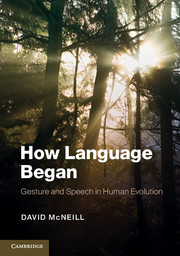Book contents
- Frontmatter
- Contents
- List of figures
- List of tables
- Preface – Out on a limb
- Acknowledgments
- 1 INTRODUCTION – GESTURE AND THE ORIGIN OF LANGUAGE
- 2 What evolved (in part) – the growth point
- 3 How it evolved (in part) – Mead's Loop
- 4 Effects of Mead's Loop
- 5 Ontogenesis in evolution – evolution in ontogenesis
- 6 Alternatives, their limits, and the science base of the growth point
- Notes
- References
- Index
6 - Alternatives, their limits, and the science base of the growth point
Published online by Cambridge University Press: 05 October 2012
- Frontmatter
- Contents
- List of figures
- List of tables
- Preface – Out on a limb
- Acknowledgments
- 1 INTRODUCTION – GESTURE AND THE ORIGIN OF LANGUAGE
- 2 What evolved (in part) – the growth point
- 3 How it evolved (in part) – Mead's Loop
- 4 Effects of Mead's Loop
- 5 Ontogenesis in evolution – evolution in ontogenesis
- 6 Alternatives, their limits, and the science base of the growth point
- Notes
- References
- Index
Summary
ALTERNATIVES
It is admittedly unorthodox to present major hypotheses – the GP and Mead's Loop – and the evidence for them before discussing alternatives and their limits, but I have had little choice. With a few exceptions, including gesture-first, which was integral to presenting Mead's Loop and the possibility of two separate origins of language, to explain alternatives and to say why they come up short or deal with other topics, the reader must already understand the GP and Mead's Loop, and this has determined the order of our discussion. This order also better reflects the actual history of this book than would a fantasy picture of surveying the field in advance, finding in it gaps, and now plugging them. More realistically I have proceeded from the GP and Mead's Loop and then discovered how other approaches resembled or differed. So with this acknowledgment we take up major alternatives, their resemblances, differences, and limits.
GESTURES – ARE THEY SUPPLEMENTS?
A supplement, as used here, is when speech and gesture cover different ideas that, although related, cannot form a single idea unit. The phenomenon is distinct from co-expressiveness, where speech and gesture express possibly different sides of one idea at the same time. Supplements can be discerned on different levels – semantic (as in the “firehose” next) and pragmatic (as in gestures in silence after that) – and the status of the two, vis-à-vis the GP, differs.
- Type
- Chapter
- Information
- How Language BeganGesture and Speech in Human Evolution, pp. 186 - 222Publisher: Cambridge University PressPrint publication year: 2012



